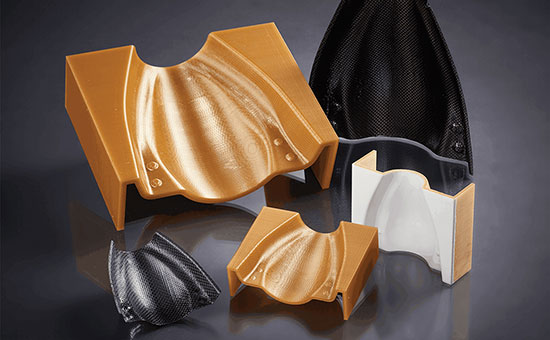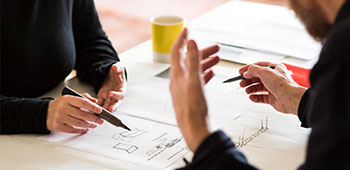Taking manufacturing to a higher altitude.
Proven to work for manufacturing.
This is about much more than just finished parts. 3D printing creates ergonomic tools that are made for your employees, and jigs that are up to five times lighter than standard solutions. Our 3D printers help you work faster and smarter – they’re a crucial part of the team.
Maximize manufacturing efficiency.
Push the limits of 3D printing for aerospace. Stratasys materials are versatile and durable, making them your perfect partners for aircraft part production – from the smallest fixtures to the largest tools. Discover how Stratasys FDM printing can help you maximize efficiency.
Click the parts to learn more.
Scroll the components to highlight their location.

Tooling Development
3D print robust, low-volume, complex tools and fixtures on-demand, in high strength, lightweight materials. Leading manufacturers have seen a 50% reduction in manufacturing cost, and an increase in production by 66%, on average, when compared to traditional methods. 3D printing also affords engineers design freedoms not possible with traditional methods, which enable the manufacture of extremely complex parts that would otherwise be uneconomical or impossible with traditional tooling methods.
Featured Material Data Sheet
Download the material data sheet for high-strength Stratasys Polycarbonate (PC) by clicking below.
Featured Material Guide
Download this material guide for a comprehensive overview of Stratasys Diran 410MF07, a durable thermoplastic with high surface quality engineered for non-marring applications.

End of Arm Tooling
When 3D printing end of arm tooling and end effectors in Nylon 12CF, a leading manufacturer reduces tooling weight by up to 61%. This led to a 19% reduction in cycle time and lead time, and a 30% reduction in material cost on average when compared to traditionally made tooling. When replacement parts are needed, 3D printed tooling enables quick resolution so your production never stops.
Featured Material Data Sheet
Download the material data sheet for impact resistant, high-strength, Stratasys Nylon 12CF by clicking below.
Case Study
Discover how FDM end of arm tooling created cost effective results for Genesis Systems Group.
Technical Guides
Find out how Nylon 12CF offers versatility and strength to manufacturing.
Featured Material Guide
Download this material guide for a comprehensive overview of Stratasys Diran 410MF07, a durable thermoplastic with high surface quality engineered for non-marring applications.

Metal Forming
Sheet metal forming methods, such as hydroforming, are an excellent opportunity to use 3D printed tooling. Stratasys has demonstrated 3D printed polymer tooling in forming applications up to 10,000 psi. Compared to machined metal tooling, additive manufacturing is faster, less expensive, and less labor intensive. These characteristics combine to make 3D printed tools an interesting alternative to support repair and refurbishment work — as found on aging aircraft — or products with high probability of design revisions.
Featured Material Data Sheet
Download the material data sheet for high-strength Stratasys Polycarbonate (PC) by clicking below.
Case Study
Discover how Stratasys FDM technology helped Corsair’s restoration process.
Technical Guides
Find out how FDM Tooling can help Sheet Metal Forming production with Hydroforming.
Featured Material Guide
Download the material data sheet for strong, heat-resistant, FST-rated Stratasys ULTEM™ 9085 resin by clicking below.

Surrogate Verification Parts
Surrogate parts are purpose-driven, non-functional substitutes for manufacturing components and sub-assemblies with high value, long lead times, and complex interfaces.
3D printing surrogate parts can help identify critical installation, manufacturing, and assembly issues, even before production components are available, without incurring the cost of production units early in the production cycle. Surrogate parts are helpful for assembly verification, machining program validation, robot training, and other applications. Have your part in hand before the production part is ready and optimize your production planning.
Featured Material Data Sheet
Download the material data sheet for high-strength Stratasys Polycarbonate (PC) by clicking below.
Technical Guides
Find out FDM surrogate production parts can help your manufacturing line.
Featured Material Guide
Download this material guide for a comprehensive overview of Stratasys Diran 410MF07, a durable thermoplastic with high surface quality engineered for non-marring applications.

Quality Inspection Tools
Aerospace assemblies require highly accurate dimensional tolerances. How do you ensure the dimensional integrity of your parts? When CMM inspection introduces cost and equipment constraints, look to additively manufactured mechanical line-side measurement templates as an alternative.
Complex geometries require complex inspection templates, which is a perfect application for 3D printed QC tools. 3D printed check fixtures reduce lead time, part cost, and part weight. Lighter tooling means less injury on the factory line, and improved efficiency. 3D printed check fixtures and go/no-go gauges allow you to produce better designs for less cost, in less time, boosting overall productivity, efficiency, and part quality.
Featured Material Data Sheet
Download the material data sheet for high-strength Stratasys Polycarbonate (PC) by clicking below.
Featured Material Guide
Download this material guide for a comprehensive overview of Stratasys Diran 410MF07, a durable thermoplastic with high surface quality engineered for non-marring applications.

Ergonomic Jigs & Fixtures
Nylon12 carbon fiber is 35% chopped carbon fiber filled by weight, giving it a high stiffness-to-weight ratio ideal for creating tools with characteristics that can replace metal tooling in select applications. Parts weigh less, can be produced for a fraction of the cost, in a fraction of the time, and allow ergonomic/custom designs not possible with traditional tooling. Reduce the occurrence of injury or repetitive strain on your factory floor with ultra-light, ultra-strong, fully functional ergonomic tooling using 3D printed parts.
Featured Material Data Sheet
Download the material data sheet for impact resistant, high-strength, Stratasys Nylon 12CF by clicking below.
Featured Material Guide
Download this material guide for a comprehensive overview of Stratasys Diran 410MF07, a durable thermoplastic with high surface quality engineered for non-marring applications.

Line-Side Manufacturing Aids
If you were to look around your manufacturing floor, assembly area, and quality control lab, how many new opportunities would you find for a jig or assembly fixture? If a given fixture makes 500 items/day/worker, a two-second savings reduces direct labor by 70 hrs/person/year. For the same part, a one-percent reduction in scrap would save 1,250 parts per year.
A multitude of additively manufactured assembly tools can be quickly printed, with optimized designs, to reduce worker injury and mistakes, increase productivity, and ultimately boost your bottom line.
Featured Material Data Sheet
Download this material guide for a comprehensive overview of Stratasys Diran 410MF07, a durable thermoplastic with high surface quality engineered for non-marring applications.
Case Study
Discover how CPI Aero Saves time producing tools with Stratasys 3D printing technology.
Technical Guides
Find out the benefits of 3D printed Jigs & Fixtures for the factory floor.
Featured Material Guide
Download the material data sheet for impact resistant, high-strength, Stratasys Nylon12CF by clicking below.

Thermoforming & Vacuum-Forming Tools
High strength, heat-resistant ULTEM™ 9085 resin is perfect for vacuum form molds and thermoforming tools, in processes up to 400° F, where uniform vacuum-pull and a high degree of precision is required. Design for optimized vacuum pull with 3D printed parts by varying part porosity and designing more efficient air channels. 3D printed vacuum-form tools are produced in less time and for less cost than traditional tooling.
Featured Material Data Sheet
Download the material data sheet for high-strength Stratasys Polycarbonate (PC) by clicking below.
Featured Material Guide
Download the material data sheet for strong, heat-resistant, FST-rated Stratasys ULTEM™ 9085 resin by clicking below.

CMM Inspection Fixtures
By 3D printing dedicated, custom CMM fixtures, organizations can cut the high cost and lead times associated with outsourcing milled CMM fixturing. Additive manufacturing allows you to orient parts in a way that’s advantageous to inspect a variety of features in a single setup, reducing inspection time and hassle. 3D printed CMM fixturing enables leading manufacturers to prioritize production, improve quality, and their bottom line. Cut lead times and cost, all while making more functional dedicated CMM fixtures.
Featured Material Data Sheet
Download the material data sheet for Stratasys ASA, a versatile, UV-stable, economic, production grade thermoplastic, by clicking below.
Case Study
Discover how Moog Aircraft cut costs and lead times with Stratasys FDM technology.
Featured Material Guide
Download this material guide for a comprehensive overview of Stratasys Diran 410MF07, a durable thermoplastic with high surface quality engineered for non-marring applications.

Composite Fabrication Tooling
3D printed tooling for composite fabrication saves time, money, and allows for geometrically complex fabrication not possible with traditional methods.
Composite layup tooling made with ULTEM™ 1010 resin enables composite part fabrication at process parameters in excess of 350°F and 100psi, making it a viable alternative to traditional composite tooling that is more expensive and carries long lead times.
Alternatively, using soluble ST130, you can create stand-alone sacrificial composite tooling that easily dissolves to produce hollow composite structures with complex geometries. Strong enough to withstand the autoclave, ST130 maintains structural stability up to 200°F at 100psi, and is able to withstand even higher cure temperatures under lower pressures. After curing, the mold is easily removed through dissolution in a water-based solution.
Featured Material Data Sheet
Download the material data sheet for high strength, heat-resistant, chemical- resistant, Stratasys ULTEMTM 1011 resin by clicking below.
Case Study
Discover how Plyform are raising the bar for Aerospace production with Stratasys 3D printers.
Featured Material Guide
Download the material data sheet for soluble ST-130, engineered for sacrificial tooling, by clicking below.

End Use Flight Parts
FAR 25.853 compliant ULTEM™ 9085 resin and PEKK-Based ANTERO 800NA polymers enable the creation of parts with superior strength, thermal and chemical resistance, and outgassing properties required for end-use aerospace applications. Common use cases include interior trim components, covers, brackets, and ECS ducting. Additive manufacturing enables freedom of design and part consolidation not possible with the geometric limitations of traditional methods such as carbon fiber or fiberglass, which often require expensive tooling assemblies with long lead times.
Featured Material Data Sheet
Download the material data sheet for strong, heat-resistant, FST-rated Stratasys ULTEM™ 9085 resin by clicking below.
Case Study
Discover how Stratasys 3D printing technologies has maximized Marshall Aerospace’s capabilities.
Technical Guides
Stratasys Aircraft Interiors Solutions can help you design and manufacture with additive.
Featured Material Guide
Download the material data sheet for PEKK-based, chemical resistant, Antero 800NA by clicking below.

Print beyond the possible.
Better manufacturing starts with better tools. And 3D printing makes it easy, allowing for shorter lead times, lower costs and more flexible designs. These are tools you can count on.
See what our high performance materials offer
Re-tool. Re-imagine.
No more make do. Instead, you can 3D print exactly what you need. Customized tools to give improved handling for each user? No problem. A 3D printed jet-powered aircraft? Of course. All made possible through 3D printing innovation. Reducing lead-times. Inspiring the future.
See how Aurora created the first 3D printed jet-powered aircraftMaking sense. Maximizing profit.
3D printing can be complex and its uses seem endless. Using your current 3D printing equipment efficiently is essential, and choosing the right 3D printing equipment in the future is critical.
Stratasys Consulting can help to drive your productivity, improve your production process using 3D printing, validate product designs as new processes, and so much more.

The days of high part counts. Numbered.
United Launch Alliance used our ULTEM 9085 resin material to manufacture parts for their Atlas V flight vehicle. That meant they could focus on printing larger components instead of countless individual parts. The result: a part count that fell from 140 to 16.








